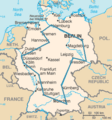Computational complexity theory facts for kids
Computational complexity theory is a part of computer science. It helps us understand how much work a computer needs to do to solve a problem. Think of it like this: when a computer runs a program, it follows a set of instructions called an algorithm. This theory looks at how many steps an algorithm takes and how much computer memory it uses.
Sometimes, an algorithm that takes fewer steps might need more memory. Other times, if there's less memory available, the computer might need more steps to finish the job. Many interesting algorithms take a number of steps that depends on how big the problem is.
Contents
How Hard Are Problems to Solve?
Constant Complexity
Imagine you want to tell everyone in a room a secret. If you shout it out, everyone hears it at once, no matter if there are 5 people or 50. This is like a problem with constant complexity. It means the computer takes the same amount of time or steps to solve the problem, no matter how big the input is. Broadcasting a message is a good example. Everyone can listen to one single broadcast, so no extra broadcasts are needed for more people.
Linear Complexity
Think about mowing a lawn. If you have a lawn that's twice as big, it will take you twice as long to mow it. This is an example of linear complexity. The time or steps needed grow directly with the size of the problem. If the problem size doubles, the time it takes also doubles.
Quadratic Complexity
Let's say you want to find out which of your friends know each other. You have to ask each pair of friends if they know each other. If you have twice as many friends as someone else, you'll have to ask four times as many questions to figure out who everyone knows! Problems that take four times as long when the problem size doubles are said to have quadratic complexity. The time or steps needed grow with the square of the problem's size.
Logarithmic Complexity
This type of complexity often shows up when you're looking for something, like finding a word in a dictionary. If the dictionary is twice as big, it doesn't take twice as long to find a word. It only takes one more step!
Here's how it works: You open the dictionary to the middle. Is your word before or after the word you see? If it's before, you only need to look in the first half. If it's after, you look in the second half. Each time, you cut the search area in half. You keep doing this until you find your word. This is called logarithmic complexity. It's very efficient!
Exponential Complexity
Some problems grow very, very fast. One famous example is the Travelling salesman problem. Imagine a salesman who needs to visit a certain number of cities, visiting each one only once, and then return to where he started. The goal is to find the shortest possible route.
This problem has exponential complexity. If you add just one more city, the number of possible routes to check can multiply hugely! This means it can take an incredibly long time for a computer to find the best solution, even for a moderate number of cities. Many interesting and challenging problems in computer science have this kind of complexity.
Images for kids
See also
 In Spanish: Teoría de la complejidad computacional para niños
In Spanish: Teoría de la complejidad computacional para niños



